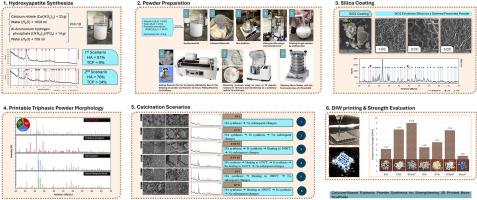用于强化 3D 打印骨支架的钙基三相粉末合成技术
IF 5.1
2区 材料科学
Q1 MATERIALS SCIENCE, CERAMICS
引用次数: 0
摘要
这项研究旨在改善生物相容性陶瓷材料的机械性能,众所周知,与金属植入物相比,陶瓷材料与骨骼的结合潜力更大。然而,要获得足够的机械强度,尤其是在承重部位的机械强度,是一项挑战。羟基磷灰石(HA)粉末的合成要考虑到机械混合和老化效应,以达到所需的成分和性能。合成的 HA 粉末在各种气氛下进行煅烧,以评估其对晶体结构的影响。研究还探讨了使用正硅酸四乙酯(TEOS)在 HA 颗粒上涂覆二氧化硅(SiO2),以增强表面改性和润湿性。这一过程产生了一种由 HA、磷酸三钙 (TCP) 和磷酸钙硅酸盐 (CPS) 组成的三相粉末。利用能量色散 X 射线光谱(EDX)、扫描电子显微镜(SEM)和 X 射线衍射(XRD)等技术分析了粉末的形态。此外,还开发了一种精制烧结程序,以最大限度地减少开裂体积,从而使抗压强度比商用材料显著提高 117%。最后,通过加水优化了粉末的三维打印,简化了其在生物医学应用中的使用。本文章由计算机程序翻译,如有差异,请以英文原文为准。

Calcium-based triphasic powder synthesis for strengthening 3D printed bone scaffolds
This study aims to improve the mechanical properties of biocompatible ceramic materials, which are known for their superior potential to integrate with bone compared to metallic implants. However, achieving sufficient mechanical strength, particularly for weight-bearing areas, poses a challenge. Hydroxyapatite (HA) powder is synthesized, taking into consideration the mechanical mixing and aging effects to achieve the desired composition and properties. The synthesized HA powder undergoes calcination under various atmospheres to assess its impact on the crystal structure. The study also explores the coating of HA particles with silicon dioxide (SiO2) using tetraethyl orthosilicate (TEOS) to enhance surface modification and wettability. This process results in a triphasic powder consisting of HA, tricalcium phosphate (TCP), and calcium phosphate silicate (CPS). The morphology of the powder is analyzed using techniques such as energy-dispersive X-ray spectroscopy (EDX), scanning electron microscopy (SEM), and X-ray diffraction (XRD). Moreover, a refined sintering procedure is developed to minimize cracking volume, leading to a significant 117 % increase in compressive strength compared to commercial materials. Finally, the powder is optimized for 3D printing by adding water, simplifying its use in biomedical applications.
求助全文
通过发布文献求助,成功后即可免费获取论文全文。
去求助
来源期刊

Ceramics International
工程技术-材料科学:硅酸盐
CiteScore
9.40
自引率
15.40%
发文量
4558
审稿时长
25 days
期刊介绍:
Ceramics International covers the science of advanced ceramic materials. The journal encourages contributions that demonstrate how an understanding of the basic chemical and physical phenomena may direct materials design and stimulate ideas for new or improved processing techniques, in order to obtain materials with desired structural features and properties.
Ceramics International covers oxide and non-oxide ceramics, functional glasses, glass ceramics, amorphous inorganic non-metallic materials (and their combinations with metal and organic materials), in the form of particulates, dense or porous bodies, thin/thick films and laminated, graded and composite structures. Process related topics such as ceramic-ceramic joints or joining ceramics with dissimilar materials, as well as surface finishing and conditioning are also covered. Besides traditional processing techniques, manufacturing routes of interest include innovative procedures benefiting from externally applied stresses, electromagnetic fields and energetic beams, as well as top-down and self-assembly nanotechnology approaches. In addition, the journal welcomes submissions on bio-inspired and bio-enabled materials designs, experimentally validated multi scale modelling and simulation for materials design, and the use of the most advanced chemical and physical characterization techniques of structure, properties and behaviour.
Technologically relevant low-dimensional systems are a particular focus of Ceramics International. These include 0, 1 and 2-D nanomaterials (also covering CNTs, graphene and related materials, and diamond-like carbons), their nanocomposites, as well as nano-hybrids and hierarchical multifunctional nanostructures that might integrate molecular, biological and electronic components.
 求助内容:
求助内容: 应助结果提醒方式:
应助结果提醒方式:


